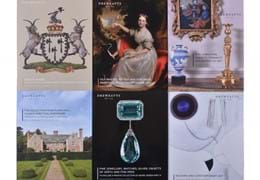The Shortlist | The Collections Award 2023 | Historic Houses x Dreweatts
We are delighted to once again be sponsoring the Historic Houses Collections Award. The Collections Award: Recognising, Responding, Reimagining joined Historic Houses' iconic award programme in 2022. It honours the creators, owners, curators, researchers, and conservators who preserve, augment, restore and interpret the beautiful and significant objects found in the rich collections found in Britain's independently owned historic homes, enabling the public to understand and enjoy them and the stories that they tell. The winner of the 2022 award was Caerhays Castle in Cornwall, whose remarkable mineral collection stood out to last year’s judges.
On the look-out, not for the ‘best’ collection, but rather for the most compelling story of custodianship from the last year or so, are five leading experts in the worlds of creation, collection, and curation. They will be looking at how these collections tell interesting contemporary stories about how historic houses are recognising new challenges, responding to changing audiences and interests, or reimagining the composition or presentation of their contents.
After a lengthy decision-making process whittling down an extensive applicant list, here is the shortlist for 2023:
Powderham Castle, Devon

The collection at Powderham Castle in Devon, covers 600 years including ancient manuscripts and a personal library with over 4,000 volumes. The fine art offers oil paintings, sculptures, and textiles, while furniture includes hundreds of pieces purpose-made for Powderham. Several are of national significance, such as the Axminster Carpet and the Channon Bookcases, owned by the V&A but held at Powderham on long loan. It also includes thousands of personal family treasures each telling unique stories of those that acquired them, curated, and have cared for them ever since. Powderham’s collection is now managed by a full-time collections manager, supported by an archivist and an interning collections assistant plus a small army of collections volunteers.

Temple Newsam, Yorkshire

Temple Newsam, in Yorkshire, is a 500-year-old stately home. It was birthplace to Lord Darnley in 1545, prior to being bought by the financier Sir Arthur Ingram in 1622. His descendants owned the house until 1922, when it was sold to the City of Leeds. Most of the contents were dispersed at this time, leaving the house denuded. However, in 1938 under Director Philip Hendy, Temple Newsam became a museum of decorative arts with two key strands of collecting established: firstly, repatriation of objects to the house; and secondly, the acquisition of the finest examples of British decorative arts up to c. 1840. Furthermore, Temple Newsam became home to Leeds’ Old Masters paintings. Consequently, the house now possesses one of the most outstanding collections of decorative arts in Britain – including ceramics, furniture, metalwork, textiles, and wallpaper – displayed in a spectacular country house.

Goodwood House, West Sussex

Goodwood House, West Sussex, has been the home of the Dukes of Richmond and their families for over 300 years. The Goodwood Collection reflects the tastes and attitudes of the successive Dukes who have formed it, and who indeed are still forming it today. The Collection comprises important paintings, including by Canaletto, Stubbs, Lely and Reynolds; significant pieces of French and English furniture by William Kent and Delanois, among others; an extensive Sèvres collection, the 3rd Duke being England's greatest patron of Sèvres porcelain; a suite of Gobelins tapestries that very unusually remain together in their original location; over 3000 books dating from the 14th to the 19th centuries; costumes, including coronation robes, a rare almost complete page boy's uniform and livery uniforms; textiles; silver; clocks; watches; sculpture; ceramics; photographs; and arms and armour.

Ushaw, Durham

Ushaw in Durham, is home to a broad collection of fine art, religious and secular objects and books. For over 200 years, Ushaw was a Catholic seminary. During this time, objects were acquired, displayed and used. The collection of Nazarene School paintings and 19th century sculpture are of particular note. Religious objects encompass church plate, recusant chalices and an important collection of clerical textiles. The latter includes the Westminster Vestment, produced in the second half of the fifteenth century and believed to have been in the wardrobe of Richard III. The library contains over 50,000 volumes, including unique early manuscripts and rare editions. The collections are housed and displayed in a range of listed buildings, most of which were designed by the Pugin family.

Cragend Farm, Northumberland

Cragend Farm in Northumberland, is home to a collection of an eclectic mix of agricultural equipment, historical & engineering artefacts that have been discovered whilst renovating the site to accompany the tours providing a sensory experience. This is enhanced with maps, documents, newspaper articles and photographs. The farm had been completely cleared prior to its sale in 2011 and not even a pitchfork survived above ground. Many interesting items have come to light, such as milk churns, heavy horseshoes, and glass bottles.

Thank you to all the applicants and congratulations to all those shortlisted!
The judges will be visiting the houses over the summer, and the winner will be announced in November.











